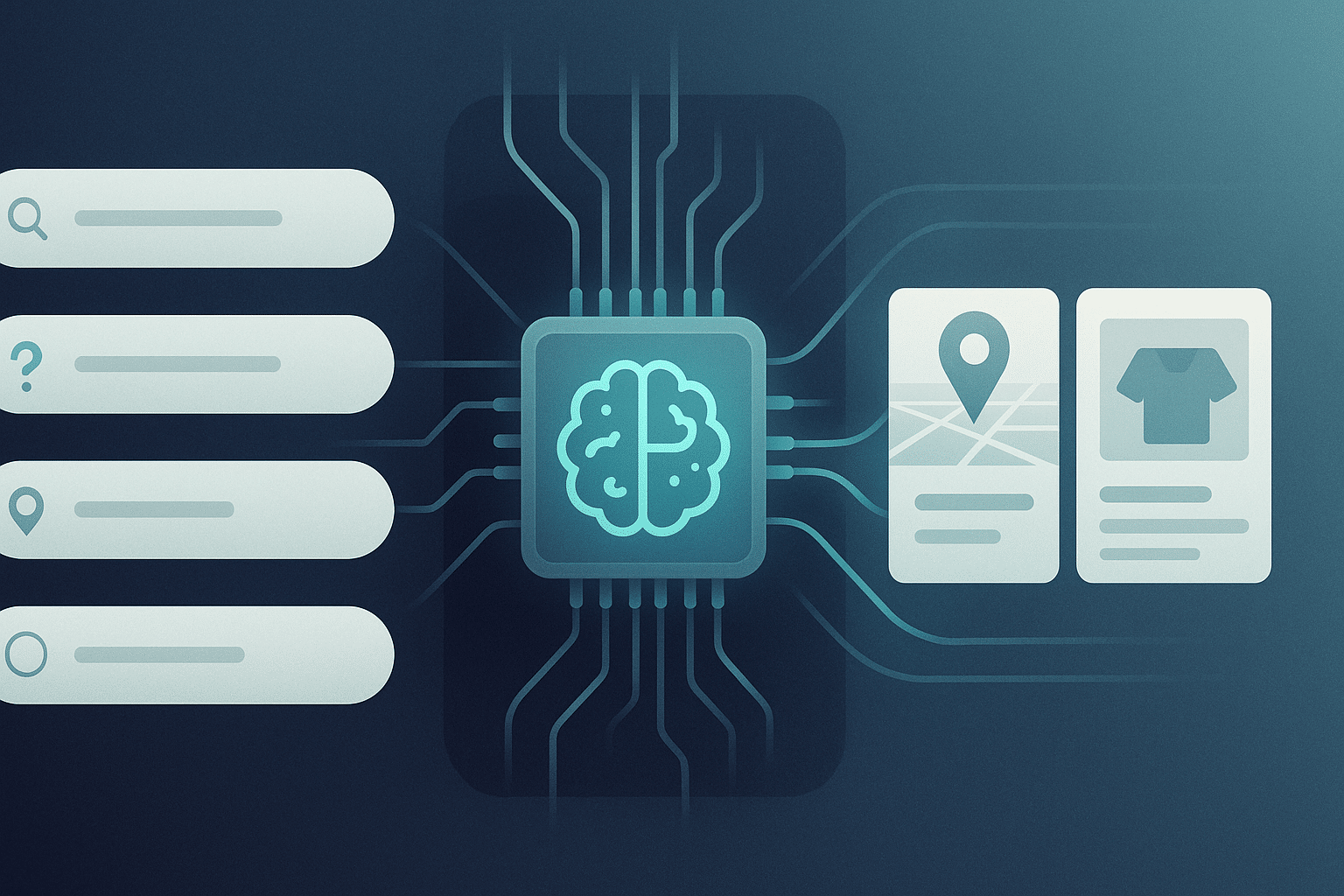Query classification is the task of mapping a user’s search or question to a known category using its intent or topic. It helps systems like search engines, chatbots, and enterprise search understand what the user really wants.
Since queries are usually short and unclear, systems apply NLP techniques, linguistic features, and machine learning models to improve precision. Accurate classification supports query intent detection, better result ranking, and smarter query routing.
Modern systems use deep learning to handle complex or vague inputs, especially when queries lack clear context.
Overview of query classification
Query classification helps systems understand what a user is trying to ask. It breaks the query into parts and places it into the right intent category or topic group. This step is key in tools like search engines, enterprise search, and conversational AI.
For example:
- A query like “apple” can mean a fruit or a tech company. The system uses query context to show either grocery links or tech news.
- A question like “how to tie a tie” gets labeled as informational, so the system shows guides or videos.
- A search like “buy iPhone 13” is transactional, so it shows shopping pages.
This helps in:
- Improving result relevance
- Matching ads with interest
Grouping results when queries have more than one meaning - Tailoring chatbot replies by detecting if the question is factual, comparative, or decision-based
In workplaces, enterprise search systems use query classification to point people to the right internal documents. A query like “employee benefits policy” gets linked to HR content.
By reading the user intent, classification boosts accuracy, makes responses more useful, and leads to better user satisfaction. It is a core part of NLP pipelines and modern information retrieval.
Types of query classification
Query classification systems often group queries into types to better understand their intent, structure, or topic. The most widely used taxonomy is based on user intent, introduced by Andrei Broder (2002). His model divides queries into three core types:
Intent-based taxonomy
- Navigational queries
These point to a specific website or known page. A query like Facebook login or CNN news signals the user’s goal is to reach that site directly. Only one result is typically correct. - Informational queries
These seek knowledge on a topic. Examples include Olympic history or normocytic anemia symptoms. Users expect to read pages to gather details but not take action beyond learning. - Transactional queries
These reflect intent to act—such as buying, downloading, or signing up. Queries like buy iPhone 13 or Netflix free trial belong here. The success of these depends on the user’s next step, not just content quality.
This three-part intent taxonomy is used in search engines and SEO systems to fine-tune search result types.
Handling ambiguous queries
Many real-world queries are ambiguous. For example, Saturn could mean a planet, a car, or a brand. In such cases:
- Systems may assign multiple intent labels.
- Some use probability distributions over intent types.
This helps cover multi-intent queries, which are common in live search logs.
Topic-based taxonomy
Another method classifies queries by subject domain, such as:- Sports (e.g. World Cup 2022 schedule) , Health (e.g. COVID-19 vaccine efficacy) , Finance, technology, and more.
Systems use predefined taxonomies like Wikipedia categories or the Open Directory Project for such classification.
A key benchmark was the KDD Cup 2005, where systems labeled over 800,000 queries into 67 topics. Each query could receive up to five topic tags, reflecting real-world overlap.
Other classification schemes
Some systems also analyze:
- Query structure (e.g. question, command, or keyword list)
- Expected answer type (e.g. person, date, location)
These schemes support question answering systems, where knowing the expected answer shape guides the system response.
How is query classification done and what are the challenges

Query classification faces unique hurdles not found in longer text processing. Most queries are short, ambiguous, and context-poor—making it harder for systems to accurately understand what the user means. Over time, researchers have built diverse methods to improve classification despite these difficulties.
Understanding the core challenges
Many web queries are just a few words long. Around 80% of them contain four words or fewer. Because of this, even a simple term like apple could mean a fruit or a tech company, depending on user intent.
Short queries introduce three key problems:
- Lack of context: Few words give little clue about meaning
- Multiple meanings: Queries like java or Barcelona can refer to unrelated things
- Shifting vocabulary: Meanings evolve over time (e.g. Saturn or Zoom)
Another major issue is data scarcity. Creating labeled datasets for intent or topic is expensive and often inconsistent, especially since human annotators might disagree without added context. While search logs are vast, they are mostly unlabeled, which limits the training of supervised classifiers.
Key methods used to address these problems
To handle these issues, various techniques have been developed—some simple, some deeply technical. They work by adding context, reducing ambiguity, or learning from behavior patterns.
1. Query enrichment and pseudo-documents
This method expands a short query into a richer context. The system retrieves search results for the query and uses snippets or document text to build a pseudo-document. Then, traditional classifiers like Naive Bayes or SVMs can be applied as if it’s a full-length text.
Example: The query java is enriched with content from top pages, which helps the classifier distinguish between coffee and programming.
2. Taxonomy-based mapping
Here, the query is first classified using a broad external taxonomy (like the Open Directory Project). That intermediate result is then mapped to the system’s custom categories.
- This “bridge” model adapts quickly to new label sets
- Reduces the need to retrain the model each time categories change
3. Unsupervised and semi-supervised learning
Clustering similar queries together (called query clustering) helps when labeled data is limited. For instance, if users searching Saturn often click astronomy links, the system can infer its meaning from patterns.
- Click-through data helps identify likely intent
- Semi-supervised methods train on both labeled and unlabeled data
4. Machine learning classifiers
Classic classifiers like logistic regression, decision trees, or SVMs use simple features such as:
- Unigrams or bigrams in the query
- Query length
- Domain suffix (e.g. .edu vs .com)
Later models added behavioral signals like dwell time, showing how long users spent on clicked results.
5. Deep learning and transformer models
From the 2010s onward, neural networks became state-of-the-art. Models like BERT learn semantic embeddings of queries and can understand polysemy, synonyms, and subtle cues in phrasing.
- Fine-tuned BERT models outperform many earlier systems
- Some newer setups use graph neural networks combined with BERT
- These hybrid models use both text and user behavior (like click data)
6. Rule-based and hybrid systems
In controlled settings like enterprise search, simple rule-based approaches still work. For example, if a query includes a product name, it might directly link to a support page.
- Named Entity Recognition (NER) helps identify key terms
- Dependency parsing aids structural understanding
- Many systems mix fast rules with slower ML classifiers
Ongoing limitations
Even with these techniques, certain challenges remain:
- Slang, rare terms, and misspellings are hard to classify
- New topics or events require frequent model updates
- Even humans may disagree on intent when context is thin
For these reasons, top-performing systems often combine multiple signals—including lexical, semantic, and behavioral features—to deliver accurate, real-time classification.
Where is query classification used
Query classification plays a central role in search technology and information systems. It helps bridge the gap between what a user types and how a system responds. From web search to enterprise tools, its use is widespread and deeply integrated into user-facing functions.
Web search engines
Search engines use query classification to improve both the ranking and display of results. Once a query’s intent is identified—informational, navigational, or transactional—the engine adjusts its response accordingly.
Additional uses include:
- Routing users to the correct search vertical (e.g. images, videos, or local results)
- Controlling ad placement, ensuring ads appear only when the query has commercial value
- Activating special search features like flight widgets or info panels
This improves search relevance, content personalization, and overall user satisfaction.
SEO and content strategy
For SEO experts and marketers, understanding search intent is now standard practice. By knowing what type of query they are targeting, content creators can shape their pages accordingly.
- Informational queries: Answered with blogs, guides, or FAQs
- Transactional queries: Matched with product pages or offers
- Navigational queries: Focused on brand pages or login portals
SEO tools increasingly use automated intent classification powered by machine learning to guide keyword research. This helps marketers prioritize content that matches what users are truly looking for, improving engagement and rankings.
E-commerce and product search
Online shopping platforms use query classification to make product discovery faster and more relevant. A query like “iPhone 13 case” signals a product intent, while “order status” reflects a support need.
Some systems also break down product-related queries into categories:
- “Men’s running shoes size 10”
Type: Shoes
Use: Running
Department: Men’s
Size: 10
This structured mapping helps filter results instantly, reducing user effort. In large-scale retail, query classification supports:
- Accurate search routing
- Facet-based filtering
- Customer service automation
Enterprise search and knowledge systems
In workplace settings, employees use internal search engines to locate documents, policies, or project details. Here, queries are often domain-specific and contain internal jargon.
Query classification helps by:
- Identifying department context (e.g. HR vs IT)
- Directing the query to the right document repository
- Applying security filters to restrict access
For example, “vacation leave policy” routes to HR content, while “server error 500” goes to IT manuals. This improves both precision and knowledge access within large organizations.
It also powers internal analytics by tracking which topics are most searched, guiding content updates and knowledge base management.
Conversational assistants and QA systems
Virtual assistants like Siri, Alexa, or chatbot systems rely on query intent classification as the first step of natural language understanding. The system needs to know whether the user wants:
- A fact (“What is the capital of France?”)
- A comparison (“iPhone vs Android?”)
- An action (“Book a table at 7 PM”), which requires execution
Well-tuned assistants use:
- Intent classifiers trained on dialog data
- LLM-based models using fine-tuning or few-shot prompts
- Clarifying question strategies for ambiguous inputs
Effective classification ensures that a question leads to a clear answer, a task triggers the correct action, or confusion results in follow-up dialogue—all handled smoothly.
Query classification continues to evolve with voice interfaces, multi-modal queries, and real-time learning. But its core function remains the same: helping systems understand and act on what users truly mean. As such, it is a foundational layer in modern information retrieval and user-centered AI systems.
References
- https://www.searchunify.com/su/blog/query-classification-what-it-is-why-it-matters/
- https://en.wikipedia.org/wiki/Web_query_classification
- https://www.kmworld.com/Articles/News/News/Guiding-enterprise-search-and-discovery-with-open-source-technologies-at-KMWorld-2022-155886.aspx
- https://medium.com/@EleventhHourEnthusiast/engineering-conversational-search-systems-a-review-of-applications-architectures-and-functional-84476b91f1a1
- https://cse.iitkgp.ac.in/~chitta/pubs/comad13-queryGoal.pdf
- https://medium.com/@seokai/broders-classification-of-keywords-16ddb1015a3
- https://www.kdd.org/kdd-cup/view/kdd-cup-2005/Tasks
- https://link.springer.com/chapter/10.1007/978-3-030-58334-7_2
- https://arxiv.org/pdf/2204.06522
- https://medium.com/@piash.tanjin/optimizing-rag-systems-query-classification-with-metadata-vector-search-2540401b9601


